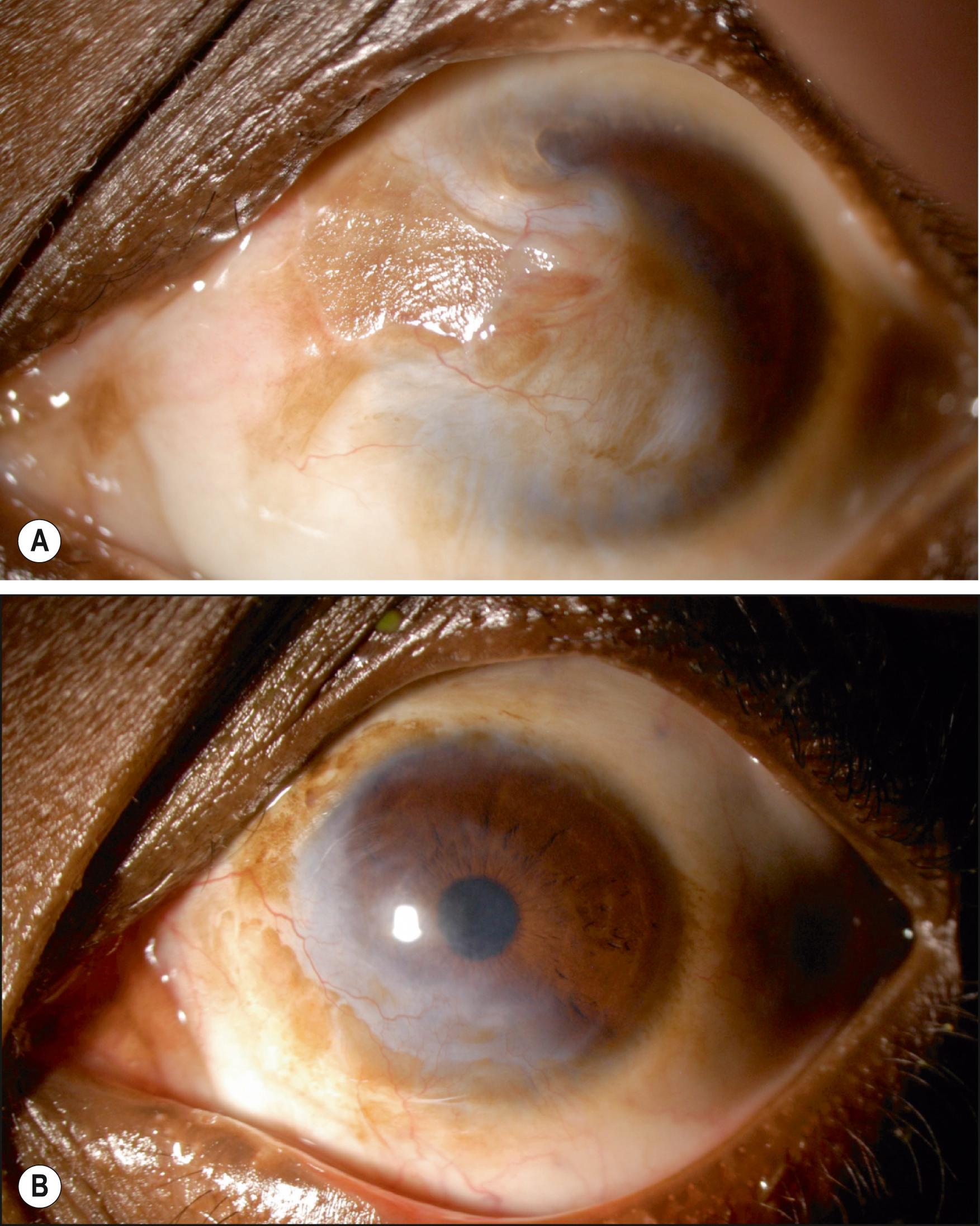Physical Address
304 North Cardinal St.
Dorchester Center, MA 02124
There has been a major paradigm shift in corneal surgery from penetrating keratoplasty to layer-specific corneal grafts.
The preoperative evaluation includes not only a general medical history but, in addition, emphasis on the specific layer of the cornea involved with disease.
Options in keratoplasty include ocular surface reconstruction, anterior or posterior lamellar procedures, penetrating keratoplasty, and keratoprosthesis.
Posterior lamellar procedures (DSAEK or DSEK, DMEK, PDEK, and possibly DSO) have evolved as the surgical procedures of choice for irreversible endothelial dysfunction.
Penetrating keratoplasty remains an important procedure for the treatment of combined stromal and endothelial disease as well as severe corneal scarring affecting all layers of the cornea.
Keratoprosthesis surgery may be indicated in circumstances in which standard keratoplasty (either lamellar or full-thickness) is not a viable option.
There has been a paradigm shift in the approach to corneal surgery, and specifically keratoplasty over the past two decades. For more than half a century, corneal surgeons have had a monolithic approach to the visual rehabilitation of the patient with visually significant corneal disease, not correctable with optical or medical therapy, that is, penetrating keratoplasty. Although surgeons recognized that the disease process affecting the cornea may not involve all of its layers, and although they were very cognizant of the perioperative and postoperative challenges in the visual rehabilitation of the patient receiving a full-thickness corneal graft, there was such comfort with penetrating keratoplasty as a procedure, combined with earlier discouraging results of lamellar keratoplasty, that penetrating keratoplasty remained the procedure of choice for most corneal surgical disease entities for many decades. Advances in surgical techniques and instrumentation over the past two decades have made it possible for surgeons to selectively target different layers of the cornea for transplantation with procedures that have been collectively referred to as layer-specific transplantation or selective keratoplasty. , Eye Bank Association of America statistics from 2018 revealed that over 60% of all keratoplasty procedures performed in the United States were partial-thickness corneal grafts.
Historically, preoperative considerations in the planning of keratoplasty included but were not limited to an assessment of the contribution of the corneal pathology to the patient’s visual compromise, the appropriateness of surgery for the individual patient, the timing of such surgery, perioperative and intraoperative considerations, and the preparation of the patient for the anticipated lengthy postoperative course after the only procedure being considered, that is, penetrating keratoplasty (PK). The preoperative evaluation included eliciting a good general and ophthalmologic history and careful examination of the eyes and ocular adnexa, including visual acuity, external examination, slit lamp biomicroscopy, evaluation of intraocular pressure, and dilated ophthalmoscopy. Although these considerations remain as important today as they were in the past, the paradigm shift in keratoplasty has led to a shift of the focus of the preoperative ophthalmologic evaluation to the identification of the location of the pathology within the different layers of the cornea and the selection of the appropriate keratoplasty procedure for that individual patient. Almost all surgical options for keratoplasty fall under one of the following categories:
Ocular surface reconstruction procedures
Anterior lamellar keratoplasty procedures
Posterior lamellar keratoplasty procedures
PK procedures
Permanent keratoprosthesis surgery.
These procedures should be considered for the following conditions:
Dry eye states
Neurotrophic states
Limbal stem cell deficiency states.
They include, but are not limited to, punctal occlusion, tarsorrhaphy, superficial keratectomy, amniotic membrane transplantation ( Fig. 110.1 ), and limbal stem cell transplantation (including simple limbal epithelial transplant and others) and are thoroughly discussed elsewhere in this text.

These procedures are usually indicated for corneal pathologic conditions affecting the anterior 85%–95% of the cornea, definitely sparing Descemet membrane (DM) and endothelium, and usually sparing the corneal epithelium and surface.
Corneal ectasias (keratoconus, keratoglobus, pellucid marginal degeneration)
Stromal dystrophies (granular, lattice, and others)
Scars from previous infections (bacterial, fungal, viral, parasitic, atypical)
Scars from nonperforating trauma.
Posterior dystrophies (Fuchs, posterior polymorphous, and congenital hereditary endothelial corneal dystrophies)
Corneal edema and bullous keratopathy (pseudophakic and aphakic)
Nonguttate endothelial dystrophy, with very low endothelial cell counts
Iridocorneal endothelial syndromes.
Limbal stem cell deficiency states (aniridia, chemical injuries, etc.)
Chronic surface disease (severe keratoconjunctivitis sicca, neurotrophic keratitis, and others).
Preservation of host endothelium, Descemet membrane, and possibly a pre-Descemet layer of posterior stroma
No requirement for donor endothelium:
Eliminates endothelial graft rejection
Decreases the overall incidence of allograft rejection
May allow for the incorporation of a larger area of affected stromal tissue
May decrease suture/wound-induced astigmatism
Because the eye is closed at all times during the procedure, posterior pressure is avoided, and there is a lower incidence of suprachoroidal effusion/hemorrhage.
There is a lower likelihood of postsurgical loss of intraocular contents in the setting of trauma than with full-thickness corneal grafts.
Surgical difficulty
Hypothetical optical effect of interface, which decreases the more posterior the location of the lamellar dissection is carried out.
Double anterior chamber in the early postoperative period.
Although this procedure does not involve the transfer of donor tissue to the host, it is indicated for the treatment of corneal pathologic conditions affecting Bowman layer and the anterior-most layers of the stroma (e.g., Reis-Bücklers, Thiel-Behnke, granular, and Avellino dystrophies).
Manual peeling technique
Microkeratome-assisted keratectomy
Excimer laser phototherapeutic keratectomy
Femtosecond laser-assisted keratectomy.
Lamellar keratectomy has the advantage of ease of performance of the procedure. The disadvantages include the relative irregularity of the resultant surface, the hyperopic refractive shift, and the possibility of subepithelial haze. The latter may be decreased by the controlled use of intraoperative mitomycin. The usual concentration is 0.2 mg/mL (0.02%) applied for anywhere from 30 seconds to 2 minutes to the residual stromal bed after removal of the anterior layer.
Become a Clinical Tree membership for Full access and enjoy Unlimited articles
If you are a member. Log in here